#biology
Text
Hey kid

Time to learn about tomato frogs.
This weird frog blows up like a balloon and makes glue. Click below to learn more:
2K notes
·
View notes
Text
Taxonomy Tournament: Cnidarian Finale
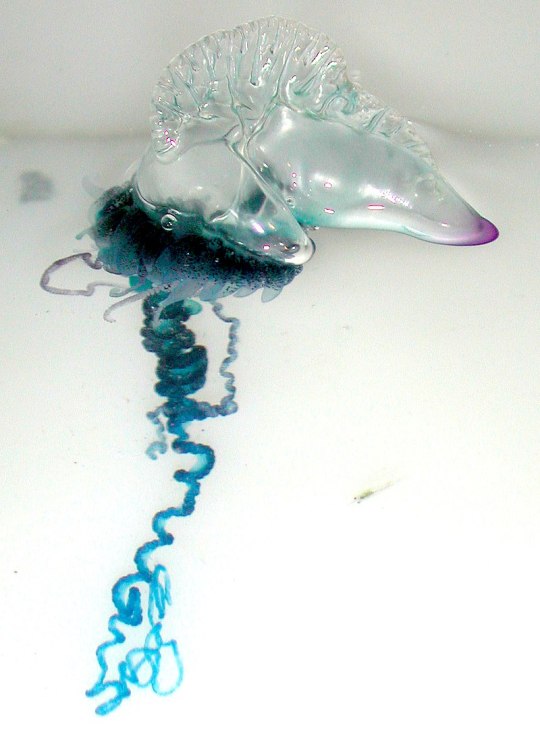
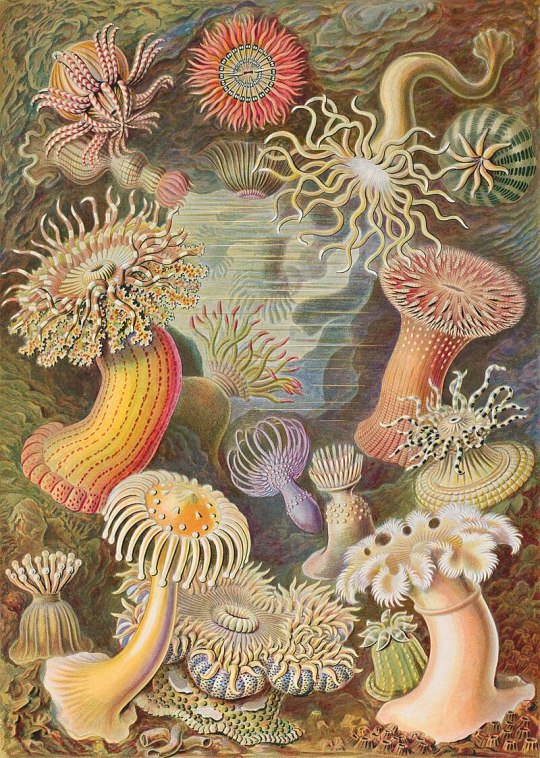
Hydrozoa. This class is of predatory cnidarians, some of which are colonial, incllude hydras and the Portuguese Man o' War
Hexacorallia. This class is made up of aquatic animals with 6-fold symmetry. It includes stony corals and sea anemones
#animals#biology#polls#poll tournament#zoology#jellyfish#hydras#portuguese man o'war#cnidarians#coral#sea anemones#Hydrozoa#Hexacorallia#0x9v0x36
309 notes
·
View notes
Text

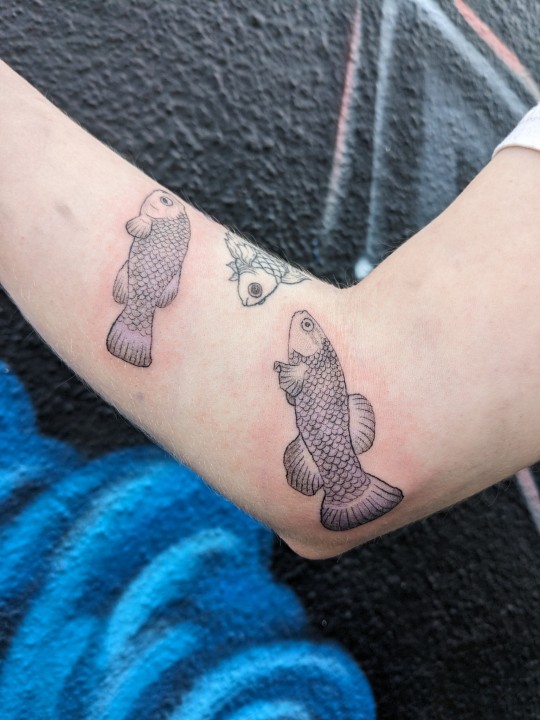
Pair of devils hole pupfish I tattooed yesterday c: The Devils Hole pupfish is a critically endangered species of the family Cyprinodontidae (pupfishes) found only in Devils Hole, a water-filled cavern in the US state of Nevada. (Goldfish in middle not by me)
100 notes
·
View notes
Text
Wet Beast Wednesday: pistol shrimp
Oh snap, it's the snapping shrimp post for Wet Beast Wednesday! Snapping shrimp or pistol shrimp are loud little critters that have evolves a very useful and fascinating tool in their pincers. Let's not waste time and shoot off to learn about these little gunslingers.
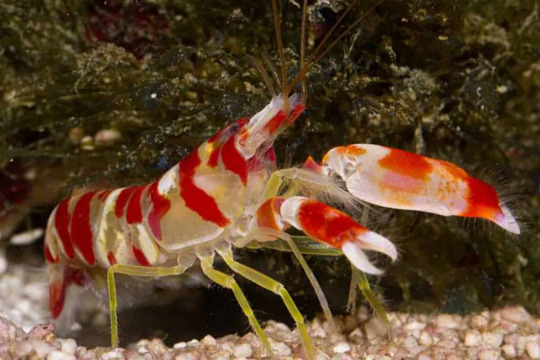
(Image: a pistol shrimp. It is a mostly white shrimp with red stripes. One of its claws is considerably larger than the other. It is standing on gravel and next to some seaweed. End ID)
Pistol shrimp are over 1,000 members of the family Alpheidae, which is part of the infraorder Caridea. This means they are true shrimp, not to be confused with superficially similar animals like brine shrimp, mantis shrimp, tadpole shrimp, and prawns. Yeah, I only recently learned that prawns and shrimp aren't a language difference between British English and American English like chips vs fries. They're not even that closely related. As true shrimp, pistol shrimp have two main body parts: the cephalothorax and abdomen, which are composed of 19 body segments. The abdomen forms a flexible tail with a fin on the end. When startled, the fin can rapidly curl under the body, propelling the shrimp backwards. Like other decapods, there are 10 limbs. The front pair of limbs have evolved into claws used to manipulate objects. The claws are the most distinguishing feature of pistol shrimp. They are asymmetrical, with one growing extremely large, over half the size of the body. The big claw has a modified version of the typical pincer. This pincer has an upper claw that can open up at a right angle. Under the claw is a pocket in the lower pincer, into which water flows. The upper pincer then slams down into this pocket, forcing the water out. The pressure of the pincer closing water in the pocket creates a cavitation bubble that is forced away from the claw at up to 26.8 meters per second. This is enough force to seriously wound small animals and hurt larger ones into leaving the shrimp alone. The cavitation bubbles can reach up to 4,427 degrees C (8,000 F) . For comparison, the surface of the sun is about 1,000 decrees (C) hotter. When the bubble pops, it creates a snapping sound that can reach 218 decibels. For comparison, most gunshots max out at around 170 db. This puts pistol shrimp is the running for the loudest ocean animals, with whales being the other main competitors. If that all sounds like a lot, the whole event happens so fast that the heat doesn't have time to affect much and the noise sounds like a moderately loud snap to us. Adults can snap their claws shut with an acceleration of up to 30 meters per second squared and juveniles can do it up to 20 times faster. The whole process takes less than a millisecond. When the cavitation bubble collapses, it can produce light. This is called sonoluminescence and nobody knows how it happens. If a pistol shrimp loses its large claw, the small claw will grow into a new large one while the missing limb will regenerate into a small claw. Adult pistol shrimp average between 3 and 5 cm long.
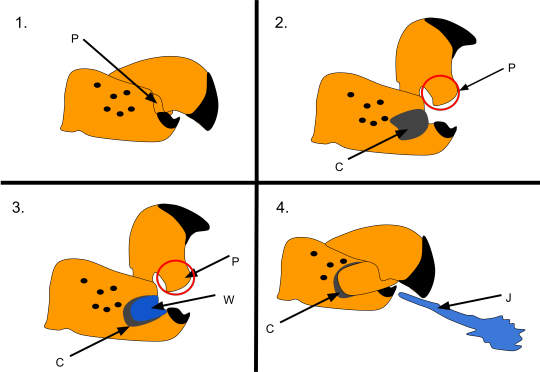
(Image: a drawing showing the process of a pistol shrimp snapping its claw. In the first panel, the claw is closed. In the second, the upper claw opens at a 90 degree angle, revealing a cavity. In the third panel, the cavity fills with water. In the final panel, the claw is closed again and a jet of water is ejected from the claw. End ID. Source: Wikipedia user Carermyers)
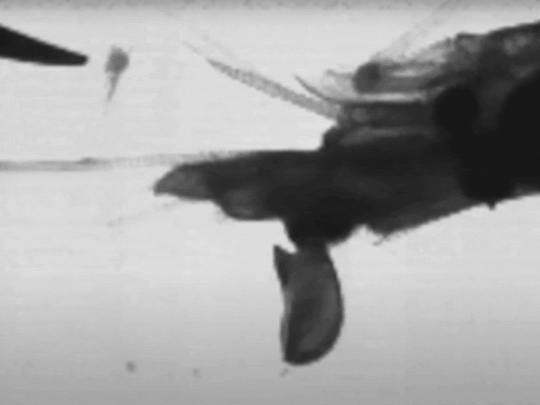
(Gif: black and white, slow-motion video of a pistol shrimp's claw snapping shut and creating a cavitation bubble. End ID. Source)
Pistol shrimp live worldwide, though most species live in tropical or temperate water. There are some cold water species and even freshwater species. Most prefer habitats where they can make burrows and where there are plenty of other animals. Coral reefs, oyster reefs, seagrass beds, mangrove groves are common habitats. Snapping is used for hunting and communication. They typically hide in burrows, waiting for fish or other small animals to pass by. When prey passes, the shrimp will snap to stun or seriously wound the prey, then drag it into the burrow. Some social species actually form eusocial hives with a single queen who produces all offspring. These shrimp are the only known marine eusocial species and all occur within the same genus (Synalpheus), though not every member of that genus is eusocial and eusociality appears to have evolved at least 3 times within that genus. It appears that a reason why only this genus developed eusociality is their larvae do not disperse, instead staying in the same area as the parents. The hives are usually located within sponges. Other social species are not eusocial, but still live together in colonies. Many less social species have formed a symbiotic relationship with gobies. Both species live in burrows, but gobies are bad at digging while the shrimp have poor eyesight. The goby will protect the shrimp while it digs a burrow, then the two live together. They will forage together, with the goby using its superior eyesight to watch for predators and warn the shrimp to get back to the burrow. Pistol shrimp are monogamous, the same pair coming back to mate over and over again (this does not apply to the eusocial species in which only the colony's queen is permitted to mate). The female is only fertile during a short period after molting. The male will stay with the female and protect her during the vulnerable period after mating and some species will remain with each other until the eggs hatch or permanently.
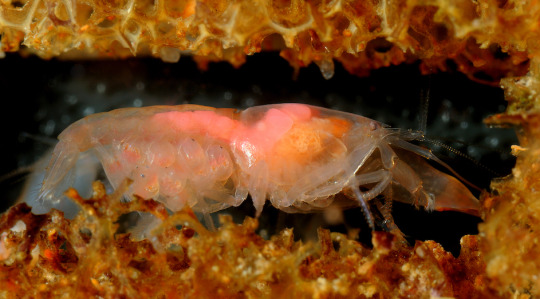
(Image: a eusocial pistol shrimp queen with eggs. Her body is translucent and multiple eggs are attached to her abdomen. The eggs look like translucent balls. The is inside of an orange sponge. End ID)
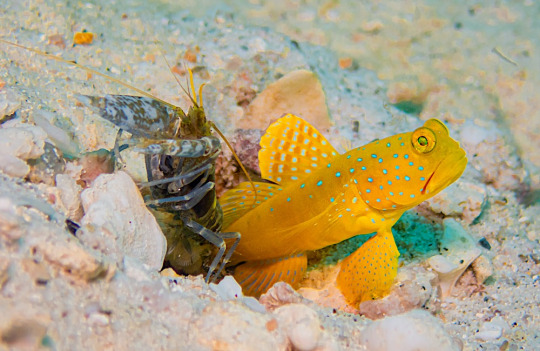
(Image: a pistol shrimp and goby emerging from a burrow in the sand. The shrimp is a mottled green and white. The body is a bright yellow fish covered with blue spots. End ID)
Pistol shrimp are a major source of noise in the places where they live. If you've ever been swimming and can hear repeated cracking noises, that may have been a bunch of pistol shrimp. Some scientists monitor the level of pistol shrimp noises as a method of monitoring the ecosystem. If the noise level drops, that is an indicator that the local ecosystem is suffering. The noise of the shrimps can get so loud that it actually interferes with sonar and forms of underwater communication. During World War II, members of the navy realized that the shrimp disrupted sonar enough to hide submarines, so they started hiding submarines near reefs with lots of the shrimp to keep them from being found by enemy subs. Weirdly not the only small marine animals to mess with submarines. I'll get the the other major one soon. The largest threats to pistol shrimp come from habitat destruction. Some species of pistol shrimp have entered the pet trade. As coral reefs, seagrass beds, and other habitats are destroyed, the shrimp that rely on them will suffer as well.

Yet another time I get to use one of these cards in a post
(Image: the Weird n' Wild Creatures card featuring pistol shrimp. End ID)
#wet beast wednesday#pistol shrimp#snapping shrimp#shrimp#decapod#crustaceans#marine biology#biology#zoology#ecology#animal facts#eusocial#symbiosis#goby#informative#image described
124 notes
·
View notes
Text
Mimicking Plant Movement

Many plants control the curvature of their leaves by selectively pumping water into cells that line the outer surface. This swelling triggers bending. Engineers created their own version of this structure. (Image credit: T. Gao et al.; via GoSM)
Read the full article
79 notes
·
View notes
Text

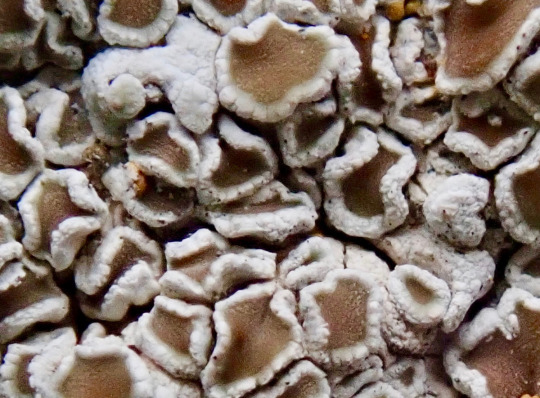

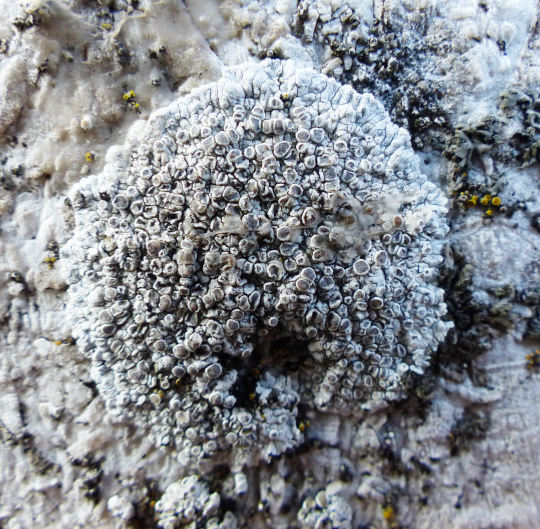


Polyozosia pruinosa
Ok but the GBIF page for this species has an adorable picture of lichen enthusiasts looking at it in their natural habitat and it is too cute?

She has her own fan club. Can you say the same? I didn't think so.
images: source | source
#lichen#lichens#lichenology#lichenologist#mycology#biology#ecology#fungi#fungus#symbiosis#symbiotic organisms#algae#trypo#trypophobia#life science#environmental science#natural science#naturalist#nature#beautiful nature#weird nature#Polyozosia pruinosa#Polyozosia#I'm lichen it#lichen a day#daily lichen post#lichen subscribe
77 notes
·
View notes
Text
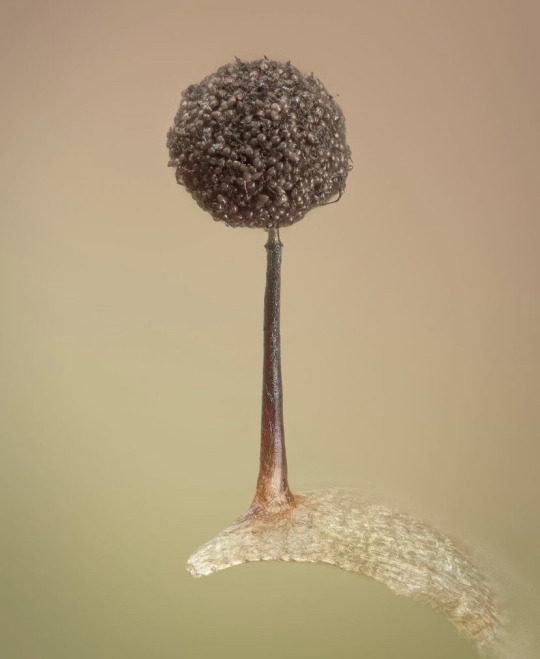
Macbrideola cornea - a tiny myxo only 0.4mm tall. the tiny ‘bubbles’ are spores.
by Karsten Buch
#macbrideola#macbrideola cornea#karsten buch#slime mold#myxomycota#slime mould#forest floor#macro photography#myxomycetes#microbiota#microbiology#microorganisms#nature photography#bryophytes#ecology#biology
62 notes
·
View notes
Text
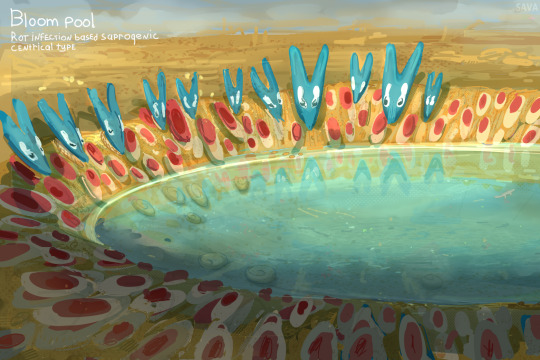
Sinedenian Bloom Pools
Rot Rings or Bloom Pools are common temporary microecosystems on Sinedey that can be found throughout foam grass biomes. They form due to the sudden mass death of a specific spot on the mat of foam grass, which can occur for a number of different reasons, such as rot, infection, fire, lightning strike, aggressive grazing by animals. Such scars on the mass of grass heal at a slower rate, since the fight of the grass mat against necrosis can drag on for up to several months. This allows water to accumulate in the crater formed, giving rise to isolated communities of organisms.
Here is a saprogenic centric type formed by a rot infection. In rot rings filled with water, colonies of moisture-loving parasitic heliophytes of all colors and shapes quickly appear, as well as small populations of aquatic plants and creatures that feed on dead tissues of foamy grass. Such organisms are adapted to life in highly acidic water.
This is just one type of rotten rings; there are also larger rotten rings of various shapes and depths, unfilled with water, with unique communities of organisms, different levels of water acidity, or with a longer period of existence. This interesting phenomenon of the planet has particularly attracted the interest of many ecologists, researchers who even “hunt” for them in search of new unique types.
59 notes
·
View notes
Text
Selected recurrent patterns or "laws" of evolution, of potential use for speculative biology. List compiled by Neocene's Pavel Volkov, who in turn credits its content to Nikolay Rejmers (original presumably in Russian). These are guidelines, and not necessarily scientifically rigorous.
Dollo's Law, or irreversibility of evolution: organisms do not evolve back into their own ancestors. When mammals returned to the sea, they did not develop gills and dermal scales and change back into fish: they became whales or seals or manatees, who retain mammalian traits and show marks of land-dwelling ancestry.
Roulliet's law, or increase of complexity: both organisms and ecosystems tend to become more complex over time, with subparts that are increasingly differentiated and integrated. This one is dodgier: there are many examples of simplification over time when it is selected for, for example in parasites. At least, over very large time scales, the maximum achievable complexity seems to increase.
Law of unlimited change: there is no point at which a species or system is complete and has finished evolving. Stasis only occurs when there is strong selective pressure in favor of it, and organism can always adapt to chaging conditions if they are not beyond the limits of survival.
Law of pre-adaptation or exaptation: new structures do not appear ex novo. When a new organ or behavior is developed, it is a modification or a re-purposing of something that already existed. Bone tissue probably evolved as reserves of energy before it was suitable to build an internal skeleton from, and feathers most likely evolved for thermal isolation and display before they were refined enough for flight.
Law of increasing variety: diversity at all levels tends to increase over time. While some forms originate from hybridization, most importantly the Eukaryotic cells, generally one ancestor species tends to leave many descendants, if it has any at all.
Law of Severtsov or of Eldredge-Gould or of punctuated equilibrium: while evolution is always slow from the human standpoint, there are moments of relatively rapid change and diversification when some especily fertile innovation appears (e.g. eyes and shells in the Cambrian), or new environments become inhabitable (e.g. continental surface in the Devonian), or disaster clears out space (e.g. at the end of the Permian or Cretaceous), followed by relative stability once all low-hanging fruit has been picked.
Law of environmental conformity: changes in the structure and functions of organisms follow the features or their environment, but the specifics of those changes depend on the structural and developmental constraints of the organisms. Squids and dolphins both have spindle-shaped bodies because physics make it necessary to move quickly through water, but water is broken by the anterior end of the skull in dolphins and by the posterior end of the mantle in squids. Superficial similarity is due to shared environment, deep structural similarity to shared ancestry.
Cope's and Marsh's laws: the most highly specialized members of a group (which often includes the physically largest) tend to go extinct first when conditions change. It is the generalist, least specialized members that usually survive and give rise to the next generations of specialists.
Deperet's law of increasing specialization: once a lineage has started to specialize for a particular niche, lifestyle, or resource, it will keep specializing in the same direction, as any deviation would be outcompeted by the rest. In contrast, their generalist ancestors can survive with a marginal presence in multiple niches.
Osborn's law, or adaptive radiation: as the previous takes place, different lines of descent from a common ancestor become increasingly different in form and specializations.
Shmalhausen's law, or increasing integration: over time, complex systems also tend to become increasingly integrated, with components (e.g. organs of an organism, or species in a symbiotic relationship) being increasingly indispensable to the whole, and increasingly tightly controlled.
55 notes
·
View notes
Text
Other posts go into more detail on this, but if you ever find a meme-like claim that a certain taxon has "never evolved" since so and so millions of years, it's most likely that, just a meme.
Crocodiles? Land crocodiles were, at many points of history, as common as amphibious crocodiles. In South America when it was a island-continent, they were among the main predators.

Horseshoe crabs? They have a rather well documented evolutionary history.
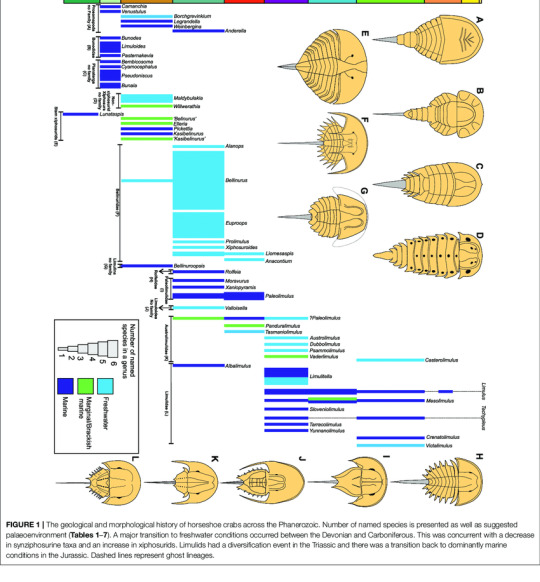
Sharks? Buddy you aren't even ready to know how fucking weird prehistoric sharks were:
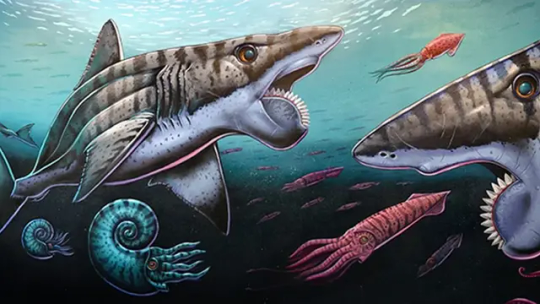


(in order: Helicoprion (ONE reconstruction, we still don't have any idea how it worked), Stethacanthus, Aquilolamna)
Yes, for sure, some life forms have been very successful, I won't pretend the amphibious crocodile body plan hasn't been very succesful and conservative since the mesozoic. Plants are also remarkably conservative (not as much as you'd think, though). But every time you see the "X hasn't changed at all for millions of years, it's the perfect creature!" it's just a meme that obscures real life evolution and diversity.
#like that annoying meme that says chickens are the most related to T-rex (no they aren't)#cosas mias#evolution#biology#paleontology#this is mostly an excuse to show you weird sharks I love sharks
70 notes
·
View notes
Text

Oil Beetle Meloe violaceus
#cottagecore#dirtcore#goblincore#nature#nature photography#biology#ecology#wildlife#wildlife photography#macro photography#insects#bugs
38 notes
·
View notes
Text
EEEEEEEE EEEEEEEEE EEEEEEE
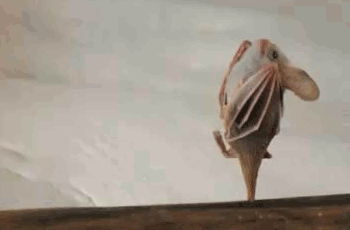
That's right! It's International Bat Appreciation Day! We share our planet with over 1400 species of bat, making the second most abundant mammal order, and they perform a wide variety of ecological roles, from dispersing seeds to pollinating flowers to eating thousands of insects in a single night! Over 200 bat species are listed as Threatened by the International Union for the Conservation of Nature--that is over 14 percent of all bats!
YOU can help endangered bats today by donating to Pennsylvania Bat Rescue at this link. This PA-based organization rehabilitates sick or injured bats and helps educate people like you and me in how we can create more bat-friendly environments.
If you want to learn about particularly-cool bat species native to New Zealand, check out this Consider Nature article on the Pekapeka, the bat that walks:
For the rest of the day, Consider Nature will be bat-bombing Tumblr with some of our favorite bat species to share them with the world!
Alt text: a small brown bat stretching its wings with the kind of fabulous flourish that would impress Ryan Evans.
#animals#nature#science#biology#wildlife#conservation#environment#bats#international bat appreciation day#batbombing
3K notes
·
View notes
Text
Taxonomy Tournament: Chordata

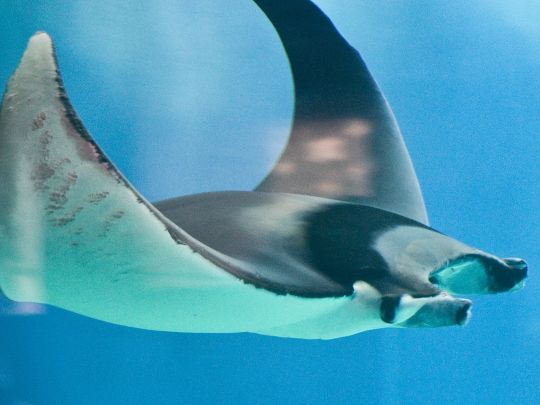
Myxiniformes. This order is known as hagfish, jawless fish which release slime from their skin to protect themselves from predators. They are the only known living species to have a skull but no vertebral column.
Myliobatiformes. This order of batoids includes stingrays and manta rays.
#animals#biology#polls#poll tournament#zoology#hagfish#stingrays#manta rays#fish#rays#Myxiniformes#Myliobatiformes#0xbv0x34
197 notes
·
View notes
Text
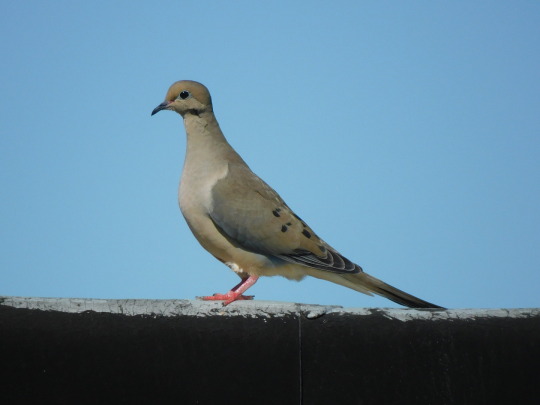


mourning dove (Zenaida macroura)
got some photos of this guy preening, i love how silly birds look when they’re preening
#mourning dove#conservation#nature#biology#wildlife#wildlife photography#bird photography#birds#birding#birdblr
43 notes
·
View notes
Text

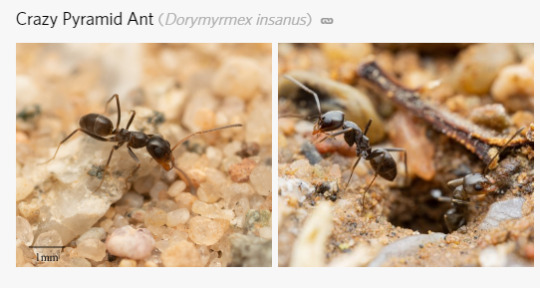
big fan of bug names that sound like they were given by the bug's bitter ex
#insect#insects#bug#bugblr#entomology#bugs#inaturalist#naturalist#nature#ecology#zoology#biology#hawk noises#if anyone has more please add them
37 notes
·
View notes
Text
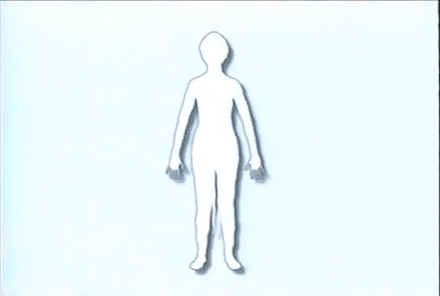
24 notes
·
View notes